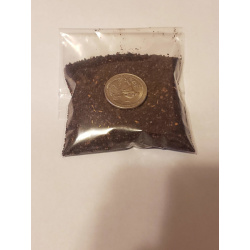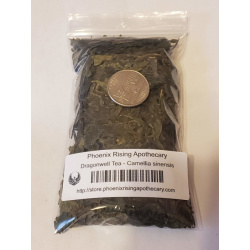Tea
Keemun Congou yields mild smokiness notes with wine-like undertones. The amber-red brew is sure to provide a rich, smooth, and mellow drink. A stronger flavor than Russian Caravan but is also lighter than the bold smoky flavor of Lapsang Souchong Black.
Keemun Congou comes from Qimen County in the Anhui Province of China. This is an area known as "The County of Chinese Black Tea." The area's high elevation and shady climate protect the tea leaves from direct sunlight, making the tea mellow yet richThe smoky, deep and distinctive Lapsang Souchong originated in China accidentally many centuries ago! Tea was carried by horse in from Yunnan to Tibet and continental Europe, acquiring its signature smoky aroma along the way thanks to exposure to the smoke from the fires burnt for warmth during the cold nights!
Our Traditional Lapsang Souchong Superior is a deeply aromatic leaf, similar to a smoky campfire, yet infuses a cup with a distinctive smoothness, topped off by hints of signature smoked pine.
To create the refined smokiness, freshly plucked leaves are withered over an open fire to infuse naturally, before being pan-fired to slow down the oxidation process and then individually hand rolled. After rolling, the leaves are pressed and stored in wooden barrels, covered with cloths and allowed to complete their oxidation.
Our Traditional Lapsang Souchong Superior smoked tea contains only the highest grade loose leaf black tea, and works well as an accompaniment to savory dishes, as well as being equally delicious on its own. If you only keep one Lapsang Souchong in your tea collection, this superior grade offering would be the perfect pick!
Enhance your beverage experience with our Matcha Blended. This sweetened powder mix effortlessly dissolves in any drink, making it perfect for creating refreshing smoothies, milk teas, flavored milk, and other blended drinks. Each bag serves approximately one satisfying serving, ensuring you can enjoy the rich and creamy goodness. Don't miss the chance to elevate your drinks!
Ingredients: Non-Dairy Creamer (Glucose Syrup, Fully Hydrogenated Palm Kernel Oil, Sodium Caseinate (Milk derivative), Dipotassium Phosphate, Distilled Monoglyceride, Silicon Dioxide), Glucose, Sugar, Matcha Powder, Silicon Dioxide, Artificial Flavoring, Sodium Carboxymethyl, CelluloseRaspberry leaves are among the most pleasant-tasting of all the herbal remedies, with a taste much like black tea, without the caffeine. Raspberries were said to have been discovered by the Olympian gods themselves while searching for berries on Mount Ida.
Herbalists and midwives continue to copy Red Raspberry’s traditional uses from the Chippewa and other Native American groups: as an effective herbal support throughout all stages of a woman’s life from menstrual discomforts to pregnancy and childbirth.
Red Raspberry is more than just a women’s tonic though, the nutritive herb builds healthy blood (high in iron), soothes gastrointestinal distress and eases digestive discomforts.
Herbalist Hint: Red Raspberry makes a pleasant tasting tea with a black tea like taste and a delicate fruity floral aroma. It blends well with fruity Hibiscus and lemony teas like Lemon Verbena & Lemongrass.
Magical:
Raspberry is served as a love inducing food and the leaves are carried by pregnant women to alleviate the pains of pregnancy and childbirth. Also used for Love and Protection.
Raspberry magic is the magic of patience in fertility. First year canes do not produce fruit but are essential to the fertility of the plant, establishing her root system and filling her canes with the strength and energy she'll need. After the cane has weathered a year, she's ready to bloom and fruit. Raspberry reminds us that maturity and proper conditioning are essential to abundant and healthy reproduction.
It is best to be patient, Raspberry councils, when beginning any creative endeavor. Raspberry's thorny canes remind us, too, to be protective of the fruits of our labors. If we truly want to share our work, we would be wise to be picky about who will carry it into the world. Birds, who cover a wide territory and have adapted strong beaks and feet that are undaunted by Raspberry's thorns, are welcomed by thorny Raspberry's canes. Bear, with his delicate claws, thick coat, and wide range is another welcome forager in Raspberry's thicket. Raspberry offers up her bounty knowing her seed will be carried far and wide by friends who have evolved the tools and techniques to pass her thorny test.
A South American relation of the Holly tree, Maté enjoys great popularity - at least in South America. In recent years that popularity has caught on in other parts of the world as well. The secret to its high esteem are not its looks, but rather to be found in its properties
. Maté is the South American equivalent of Coffee or Tea. Maté bars are as ubiquitous as coffee houses in Europe or North America. But its consumption is far more ceremonious than that of our favorite brown brews.
Mate is traditionally served not in cups, but in little gourds, from which it derived its name (Mati was the name of the gourd, which in time attached itself to the herb itself). The gourd is half filled with the cured and cut Maté leaves and topped with hot (not boiling) water. The resulting tea is sucked through a 'bombilla', a metal straw that ends in a kind of sieve, which prevents the leaves from clogging up the tube.
Maté contains less caffeine than coffee, but more than black tea and is a hugely popular stimulating beverage. It first became known in the West via the Jesuits who learned about Maté from the Guarani Indians of Paraguay. They tried the tea and liked its effect - so much so, that in the early days it was also known as 'Jesuit tea'. Today, worldwide demand has risen dramatically and Maté plantations have been established to meet the demand.
Medicinal Uses:
Maté tea is an effective, refreshing stimulant, which can be drunk as a substitute for Tea or Coffee. As an effective nervous system tonic it refreshes the mind and enhances memory, while combating fatigue, nervous exhaustion and stress. It also counteracts certain types of headaches and depression. In Western herbal medicine it has been used for attention deficit syndrome. Maté is rich in vitamins and amino acids an can suppress appetite, a property which has made it a popular choice in certain herbal weight-loss formulations. In South America it is used as a blood cleanser and antioxidant, immune system stimulant and anti-inflammatory agent. Its anti-inflammatory properties rely on its ability to stimulate the production of cortisone.
Magical Uses:
The Guarani Indians consider Maté one of the most important herbs the creator God has given them. It is widely used in ceremonies to facilitate clearing the mind to focus on the ritual. It is almost always used in healing rituals as a base for other healing herbs. Guarani shamans sometimes use this herb to achieve a clairvoyant trance. It also plays a role as an aphrodisiac.
- 1

















